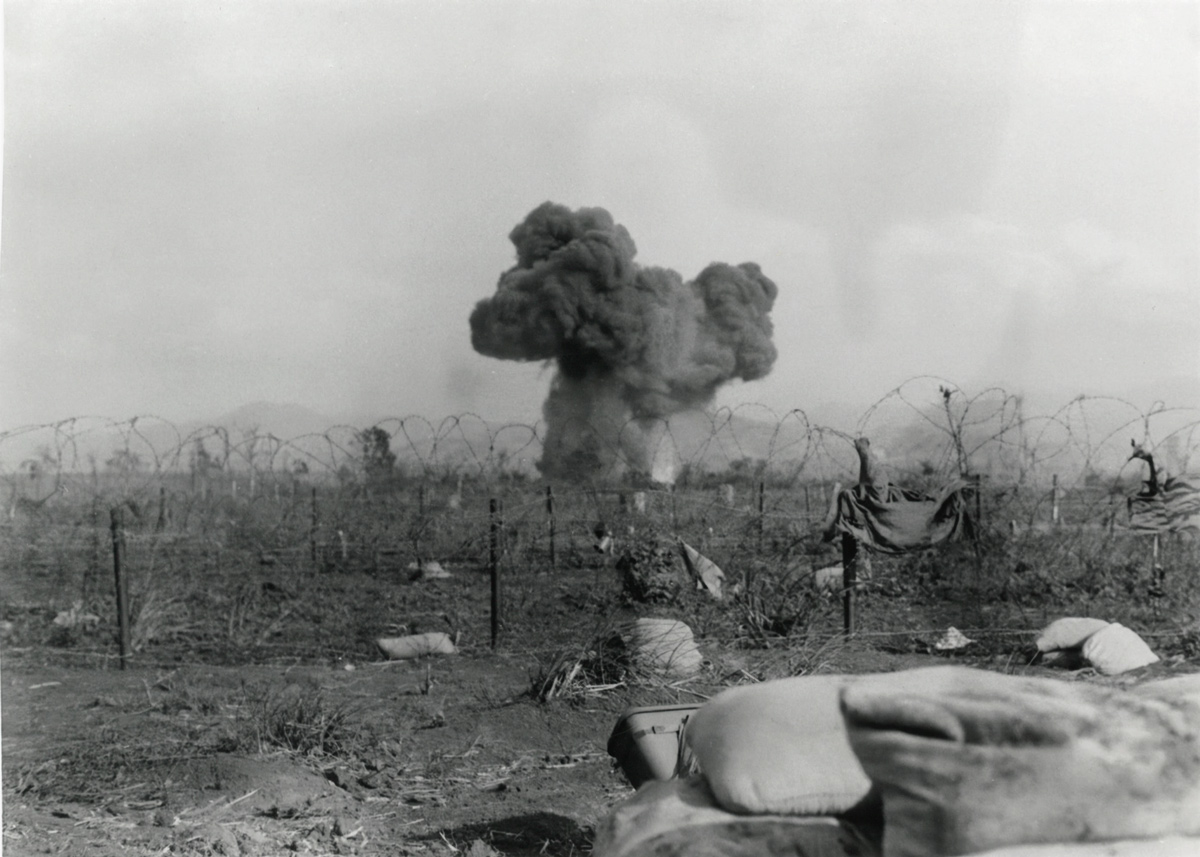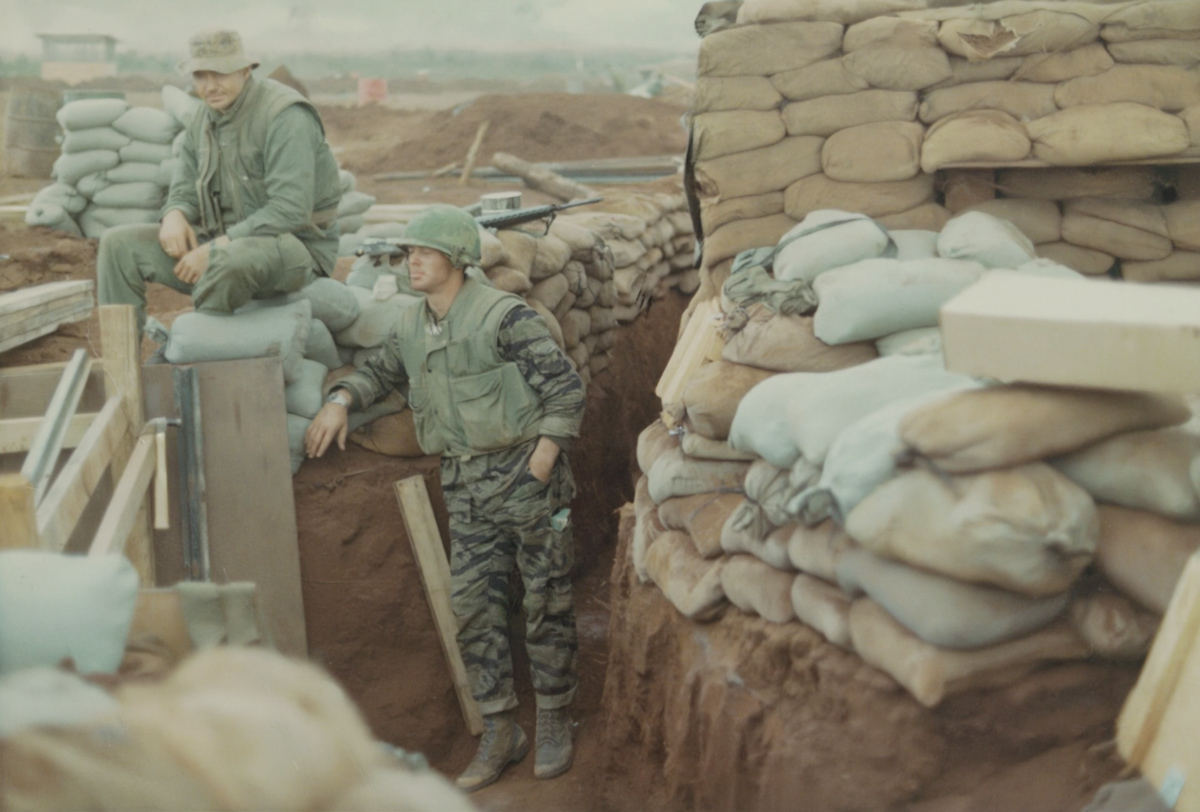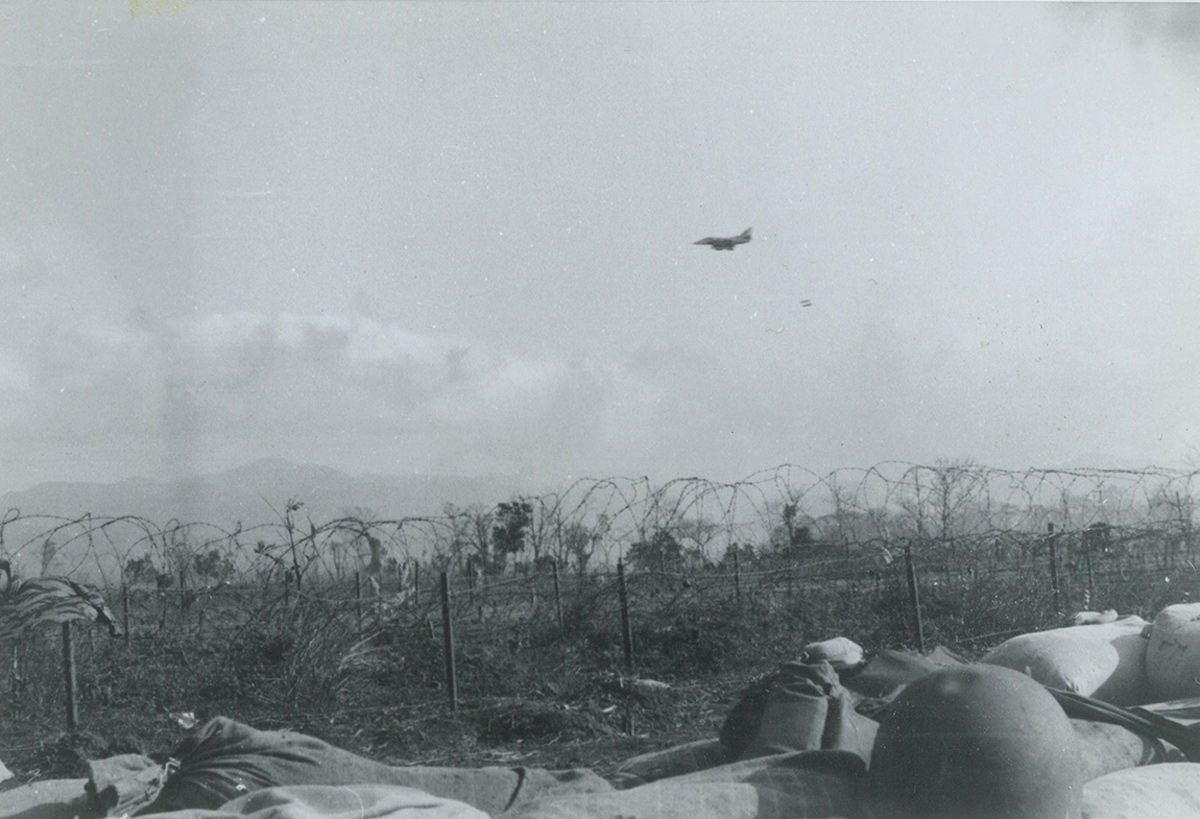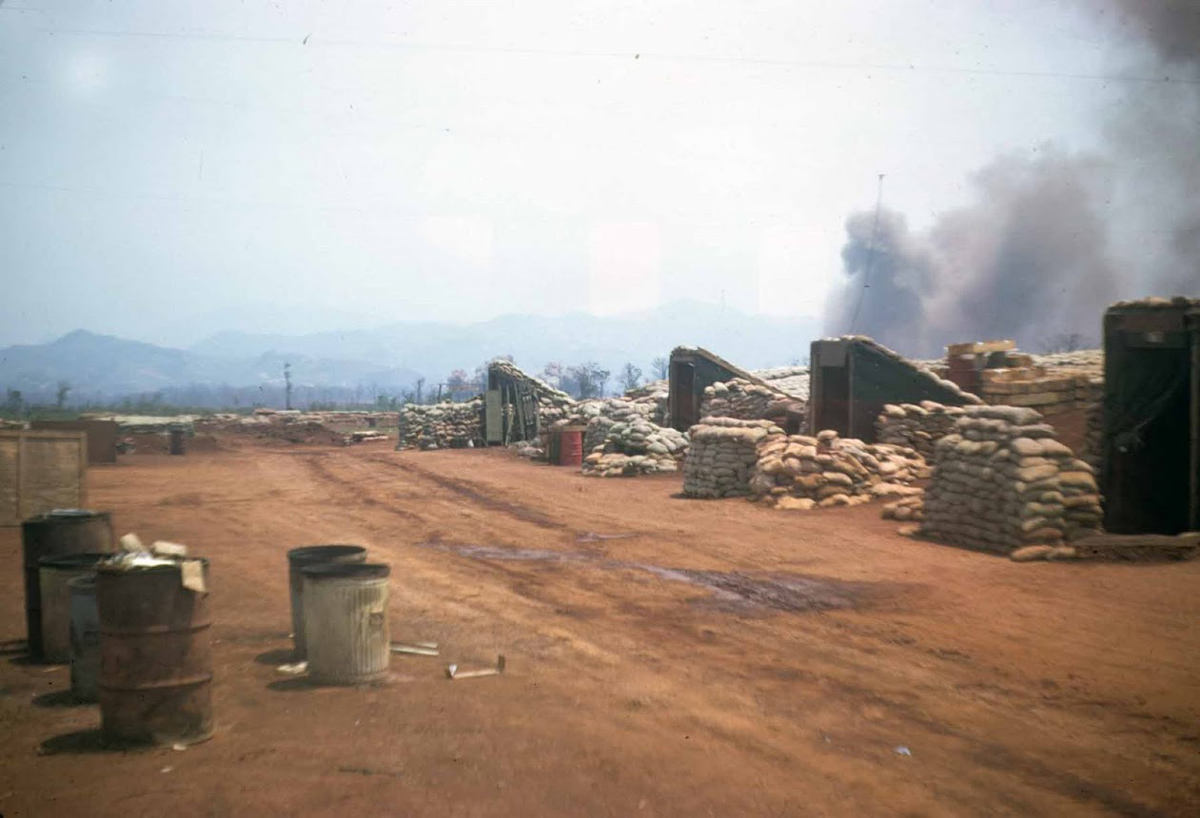The Finger of God

A 500 pounder in front of my position. (Photo courtesy Russell Mann)
By Russell Mann
The air show going on over the trench line at the Khe Sanh Combat Base during the siege of 1968 was spectacular. For a little over 2 months the Air Force, the Navy, the Marine Corps, and the US Army filled the air with B-52s, fighters, bombers, cargo planes, helicopters, gunships, and observation planes. It was seldom you could look up and see an empty sky.
President Lyndon Johnson had told his Generals quite clearly, “I don’t want no damn Din Bin Foo,” referring to the terrible defeat the French had suffered at the hands of the Viet Minh in 1954 at Dien Bien Phu. Clearly, it was a similar situation. The Khe Sanh Base was in a valley surrounded by hills. Common military wisdom has always been to hold the high ground, but the high ground seldom has room for a large airstrip. The valley floor, in this case, did, so that is where our base was.
Khe Sanh was completely cut off. The North Vietnamese had assembled an attacking force of twenty to thirty-thousand infantry soldiers and held all the surrounding terrain, exactly the situation the French had been in.
Lang Vei, the closest American position had been quickly and decisively overrun by the advancing NVA. Highway 9, a two-lane dirt road, and the only land access to Khe Sanh had been cut off. Air was the only way into the base. All the beans, bullets, and bandages came by air.
In addition to being our only supply line, air power was also our strongest weapon. Historians have said of the battle, “It was the most concentrated application of aerial firepower in the history of warfare.” On an average day, 350 tactical fighter-bombers, 60 B-52 bombers, and 30 light observation or reconnaissance aircraft operated in the skies near the base. 100,000 tons of bombs were dropped around the Khe Sanh base during the siege. To help you get your head around that, it is about the weight of a fully loaded nuclear-powered aircraft carrier, or you could think of it as almost half a million five hundred-pound bombs. It is the equivalent explosive force of three Hiroshima-size atomic bombs. Of course, it was spread out over 77 days and some few square miles. Nevertheless, that is a lot of bombs.
The North Vietnamese were getting their licks in too, pounding the base with artillery, rockets, and mortar fire. On multiple days, the incoming rounds numbered more than a thousand. The Khe Sanh base was only a half mile square, so that is an incoming artillery round for every 4 square feet on one day.

We were constantly improving bunkers. (Photo courtesy Russell Mann)
All this math is just to help you grasp the enormous number of explosions going off on and around the base. As you can appreciate, the soldiers on both sides dug trenches and bunkers as if their lives depended on it. A good bunker could protect you from a near miss, but nothing could save you from a direct hit. Everyone had a near miss story, the one that almost got them. A sense of fatalism prevailed that could manifest in two primary ways. You could say “Fuck it!” and lose behavioral inhibitions because you were going to die anyway, or you could work hard and be nice to everyone because any moment could be your last and God, or maybe Mom, would care what kind of a person you had been. Forays above ground were kept to a minimum and always with a sense of where the nearest hole was.
The weather was a player in the battle. The monsoon overcast, rain, and fog favored the North Vietnamese Army with their five to one numerical superiority. The sunny days, however, belonged to the Americans because the Air Force came out to play and it was the NVA’s turn to hide in a hole. When the sun came out and the incoming rounds began to taper off, we would creep outside by degrees, easing further and further from our sandbag caves, seeking the light like an emerging tulip in the spring. The longer the enemy artillery stayed silent, the further out we came, stripping off our soggy dirt-caked clothing, bathing our skin in the restorative tonic of sunshine.
It was on a sunny day, then, that my section of the battle line crept into the sun. Standing above ground, basking in the light, and waving to friends 50 yards away that we hadn’t seen for a week.

Fast Mover shows proximity of air support. (Photo courtesy Russell Mann)
The Air Force fighter/bombers were putting on a show. Fast Movers, we called them, and fast they were. They came in low from behind us, streaking across our lines and firing rockets into the enemy positions to our front. They would fire their rockets from well behind us, the jets would pull up as they crossed our lines and the rockets would continue their trajectory toward the North Vietnamese positions, exploding in a cascade of smoke and fire. It was spectacular to watch. The jets came in pointing, it seemed, right at us, growing larger and larger. Then the rockets would light up under their wings and flash over us as the planes pulled into a roaring vertical climb over our heads.
One young Marine, a little quicker off the mark than the rest of us, climbed out of his trench as the next wave of jets began their run behind us to capture this once in a lifetime image on his treasured Nikon camera, a souvenir from his last leave in Japan.
Nikon cameras, Sony reel-to-reel tape recorders, and Seiko watches were the treasures of the orient we collected. For our moms, Noritake dinner china, Mikimoto pearls, and Shiseido makeup were shipped home or tucked in our foot lockers awaiting our return as blooded warriors, bringing home tribute and booty.

TOC, FOB 3 command bunker with incoming artillery. (Photo courtesy Russell Mann)
If the Air Force had given us a little notice, we all would have been out there with our cameras, but as it was, only one young man was quick enough to capture this on film. He stood on top of a sandbag bunker facing the incoming jets as they screamed in from our rear. Getting, I am sure, spectacular footage as they came directly at us, wingtip to wingtip, trailing a plume of kerosene fumes. The rockets, hanging under the wings of the jet fighters, ignited and moved ahead of the jets leaving multiple trails of white smoke, stark against the blue sky.
We raised our fists and yelled triumphantly, “Kick some ass!”, “Get some!” in our joy at making the NVA cower in their holes as we had in ours.
One of the approaching rockets, due, perhaps, to some minor manufacturing defect, or maybe the finger of God, separated from the cluster of screaming rockets on a path of its own. It dropped well below the path of its partners. The last image our intrepid photographer captured was a head-on close-up of a 2.75-inch rocket with a high-explosive warhead. Apparently, he was too soft a target to set off the impact fuse in the rocket, because it didn’t explode till it hit the ground behind him.
The call of “Medic! Medic!” went up. I was 50 yards away watching the airshow and had witnessed the errant rocket. I ran to his side to find him neatly decapitated and in no condition to benefit from my efforts. There is a moment of dislocation that occurs when confronted with a headless body. Even though you can’t save him, your mind craves a complete image. Where’s the head? His head had apparently rotated to another plane of existence and left not a shred.
His nineteen-year-old body could not quite believe his death and made a few agonal attempts at breathing before he lay still. There is no stillness like the stillness of the recent dead. They look just as they did a moment before death, but have transitioned to an image of themselves, a sculpture bereft of breath. There is a slackness of the musculature that goes beyond the relaxation of sleep.
I don’t know what happened to his camera. If it survived, it had a Pulitzer Prize winning image on the last frame.
Seemingly random events like this make you start thinking about Fate, Kismet, Destiny. What forces conspired to put this young man in the precise space and time that would also be occupied by a missile on the wrong course. It’s hard to accept as a random event. The odds are too astronomical. If it wasn’t random, is there a God? What cosmic scheme required this man’s death? What did the funeral director do when his remains arrived home, perhaps gently suggest a nicely framed photo beside a closed casket?
There was another soldier injured in this incident. He had been standing ten or fifteen feet away. He was lying unconscious and had a significant facial injury that impeded his ability to breath. The headless guy was left to his own devices as I struggled to save another. His loosely attached pieces of face were occluding his airway. I performed my first (and, in retrospect, not my best) combat chrichothyrotomy. If you are not medically literate, it means cutting a new hole in the throat to breathe through. This procedure should never be taken lightly, there is a lot of important stuff you should avoid cutting that lies nearby. I had been trained in the procedure and had practiced on dummies and cadavers, but the pressure was on.
The soldiers around me watched, mouths open, breath held. There was no sharp-eyed instructor to judge my performance, only Death awaiting his turn if I failed. There was little in the way of surgical niceties. Problems with infection could wait for another day. A stab wound was made with a Buck knife between the cartilage rings of the trachea. The blade was then twisted to pry an opening I could slip an airway into. Quickly, if not neatly, done. The stuttering heaving of his chest became smoother, and he was alive, his face obscured by bandages, when I loaded him into a Huey for evacuation.
I never found out what eventually happened to him, just as I never found out what happened to any of the casualties I treated, save one. But that is another story.
ABOUT THE AUTHOR
Russell Mann’s hometown is Redding CA. He joined the army in 1965 “after missing a first period English class one too many times.” He was assigned to 1st Group after training as SF Medic. He went to Vietnam TDY to MACVSOG, arriving at Khe Sanh with his team in late January, 1968, just as the Tet Offensive and the 77-day siege began. He joined the Reserves in 1969, retiring in 1995. From 1969 until 1980 Russ worked in construction in the San Francisco Bay Area. He then successfully challenged the nursing licensing board and worked as an ER Nurse in Truckee, CA until 2015. Russ currently lives in Minden, NV.
I was privileged to serve in the same SF Reserve unit with Russ Mann, for whom I have the greatest of respect and admiration, not just as a soldier but as a warm, caring person the likes of whom I have seldom seen. The last time I saw Russ was on the sad and historic occasion when we cased the colors of the 3rdBn of the 12th SFG(A) leaving us all with our memories. Bis Valhalla, Russ.